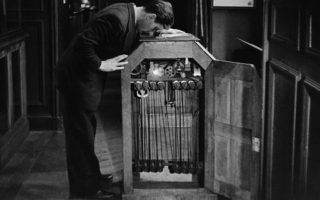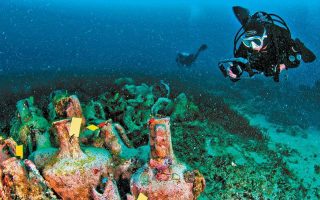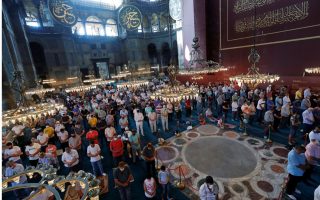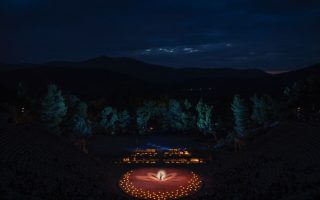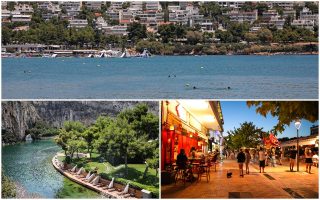Rock climbing in Meteora: Touching the divine
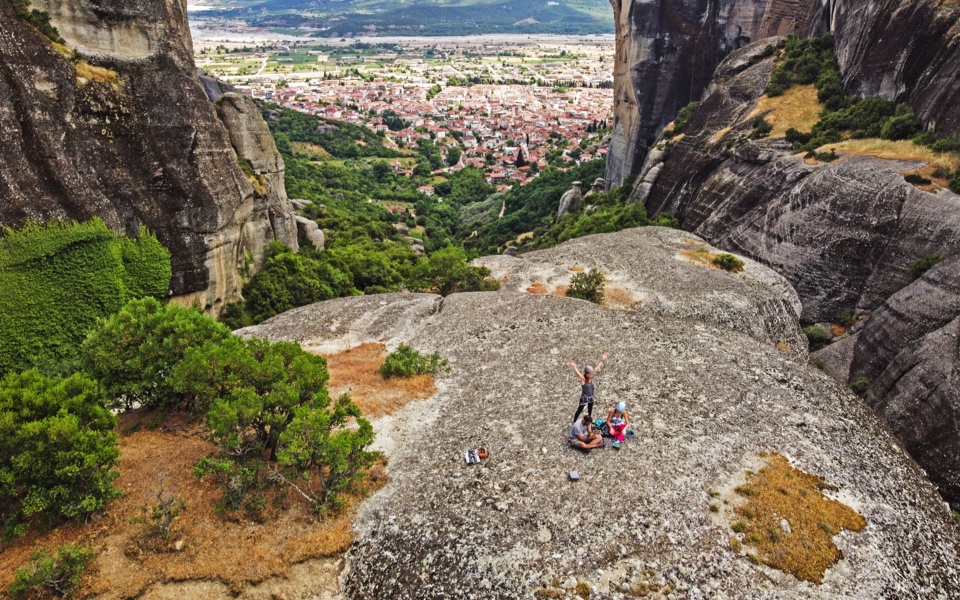
Since my arrival here, all I’ve been hearing are strange names like “Pillar of Rain,” “Line of the Falling Drops,” “Corner of Madness,” “Lightning Rod,” “Stairway to Heaven” and “Bride of Satan.” It turns out they’re all names of climbing routes, and the rock climbers around me can’t decide which one to tackle first.
In Meteora, there are 170 peaks and 870 routes to choose from. It’s a place where your instinct to climb really kicks in, and you don’t often find yourself in spaces like that.
After two months of lockdown, Camping Vrachos, the climbers’ favorite lodgings in Kastraki, recently opened again, and loyal visitors are thrilled. Around the campground, clothes are drying on climbing ropes held up by carabiners. In the central kiosk, there are ropes, helmets and climbing shoes.
Maps and guides lie open on the benches and impatient rope partners are hunched over them. A curious dialect is spoken in the shade of the trees, peppered with phrases like “multi-pitch,” “top-rope,” “cams” and “nuts.” These are all tools and techniques unfamiliar outside of climbing circles, but the campers here all understand each other perfectly.
Of course, rock climbing isn’t the only reason to come to Meteora. This haunting landscape with its giant rock pillars seemingly dropped from the sky is enchanting, to say the least.
And if you take into account the fact that, from the 11th century onward, even before the famous monasteries atop the buttes were constructed, ascetics would climb here without any safety equipment, you get an extra dose of awe. For its incredible natural and cultural value, UNESCO has included it in its World Heritage List.
Organized monastic community life reached Meteora in 1340, brought here by a monk from Mount Athos named Athanasios the “Meteorite,” who climbed to the top of Platys Lithos, the region’s largest rock, and named it Meteoro, thus baptizing the area forever. He founded the Church of Panagia Meteoritissa Petra, and, eventually, the Great Meteoron Monastery.
Early monks used wooden scaffolding and ladders to reach the heights upon which their monasteries perched. Later, monks pulled themselves up in nets or iron cages using ropes. These terrifying means of transport ceased to be used in 1922, replaced by the stairways you see today.
Climbers love it here, and not just because of the awe the place inspires in them. The physical challenge is great: soaring rock faces, bizarre grips on faces of conglomerate rock and bolts (where climbers secure themselves as they move up routes) that are few and far between; this is because many of the climbing routes were opened 40 years ago with meager means.
At the Taverna Paradeisos, local climber Vangelis Batsios, who oversees route maintenance, shows me old photographs: “This is Dietrich Hasse in the 1980s. Look at these shoes, look at that harness!” In the photographs, some climbers are barefoot, while others have climbing shoes on. Many are wearing ancient climbing harnesses. They’re a brave bunch, if a little mad, too, just like the area’s first holy residents – got to have faith, as it were.
Climbing ethics do not allow for the addition of more bolts today – although the rock is favorable to the use of slings as an extra safety measure. “If people did it this way, this is how you’ll do it, too,” Nikos Lazanas tells me. “A route is like a work of art: Once it’s finished, you don’t go and alter it. This is what climbing ethics dictate. If you want to make it, get better at it.”
Lazanas is a member of the Hellenic Mountain Guides Association and a mountaineering and climbing instructor with the Hellenic Federation of Mountaineering & Climbing. I first find him climbing the famous rock of Adrachti.
“Meteora is characterized by slabs and cracks – and cracks aren’t that common in Greece,” he tells me. “They aren’t bolted. You put your own bolts in as you go, which makes the experience even more attractive and challenging. It is the art of climbing at its purest. Here, the routes aren’t simply sport routes, as we call them; they are noble routes. Of course, there are also more relaxed routes, just as enjoyable as the harder ones, because the landscape is extremely beautiful wherever you climb.”
It is said that Meteora is hard for beginners, and even the most experienced climbers tell me that it’s difficult when they find themselves having to cover 6-meter distances between bolts. Maintaining a good frame of mind is key. All your feelings at Meteora are heightened.
Hikes beneath the pillars
As I wander through the area, I wonder when the thousands of visitors who usually come every year will reappear. Meteora is one of the most famous places in Greece. All I’ve found so far are a few foreigners who’ve been happily trapped in Greece for three months and are now going back home with heavy hearts.
I’ve also encountered a few Greeks as I pass the monasteries. The busiest ones are the famous monasteries of Great Meteoron, Varlaam and Agios Stefanos. The trio of Rousanou, Agia Triada and Anapafsa are bathed in silence.
Walking is the best way to feel connected to the land here – the best way, that is, if you don’t climb. There are dozens of paths and you can easily find your way around (even if the trail marking is a bit lax), especially if you bring along a map of the region.
Most of the paths are old, and once connected the monasteries and hermitages; some are well-made cobbled trails cutting through dense vegetation.
In general, nature is an impressive presence here. The walking routes are well-shaded, the birdsong rarely stops and I see dozens of tortoises as I head from place to place. The setting is straight out of a fairy tale.
The easiest and shortest routes are those that pass through the pillars closest to Kastraki. The hike to the small church on the rock of Agio Pnevma is an easy one, and you can carry on from there to the summit.
From the top, you can see the Monastery of Agios Georgios Mandilas, built in a cave on another rock pillar, with scarves placed to mark the holy vows made, and you can spot the “Monk’s Prison,” too. This is a cave that monks who felt they’d sinned used as a place of self-punishment.
Another splendid walk departs from the oldest part of Kastraki and takes you to the “square” formed between the pillars known as Pixari, Badova and Abaria, from where you can see the Monastery of Agios Antonios, the hermit caves of Agios Grigorios and, with extra effort, the Monastery of Agios Nikolaos of Badovas.
The path that starts near the Anapafsa Monastery and ends at the Great Meteoron is also well-known.
Now, on a similar hike between the Mikra Teichi (“small walls”) and Delta Spur sectors, I find my friends, and they’re climbing. I’m ambivalent about joining them, but they put a harness on me, pass a rope through it and I begin heading up, with shaky legs. I’m sure I won’t be able to handle the height, even though this pillar isn’t that tall.
To my surprise, I reach the top without much difficulty and we write our names in the book next to those of all the others who’ve made it up here.
This place may not be for beginners, but finding myself up here is like a dream – I’ve defied the height and my fears, the same fears that would have paralyzed me had I been in any other part of Greece.
The sense of awe, the beauty around me and the realization of where I am encouraged me along the way. As did Roula, of course, who’s been right at my side, helping me. Now, from way up here, the people and the cars below look like toys.
Looking one way, I have a panoramic view over the town of Kalabaka; looking the other way, I can see the monasteries, and climbers on neighboring pillars dangling like spidermen in the air. And then suddenly I realize how low this “great” height is that I’m standing on, because I can see much taller rocky giants rising up around me, making me feel microscopic again.
INFORMATION
Stay
In Kastraki, you can stay at Camping Vrachos (tel 243.202.2293) or at the Dellas Boutique Hotel (tel 243.207.8260, dellasboutiquehotel), or the guesthouse Sotiriou-Petrinou (tel 243.207.8105).
Eat
Taverna Zioga (tel 243.202.2286) is renowned for its food, while Paradeisos (tel 243.202.2723) is famous among climbers; both serve good meat. Skaros in Kalabaka (tel 243.202.4152) has good lamb kebab. Climbers often choose to eat at one of the many good souvlaki joints on Kalabaka’s main street.
In Kalabaka, ask for “sapoune,” a local semolina treat, from the patisserie Robos and “spatula” (a type of pudding) from the patisserie Kyvelia.
Τhis article first appeared in Greece-Is.com, an English-language publishing initiative by Kathimerini.

